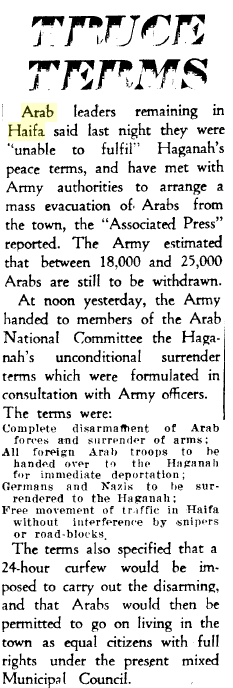“If you are in an Arab neighborhood, you have a community. If you live in a Jewish neighborhood, you are a stranger, and that gives you freedom as an Arab woman,” said Fidaa Hammoud, 32. “There are many de facto couples, and older women living alone without having to hear gossip.”
Ms. Hammoud moved to Haifa in 2011 after studying speech therapy for four years in Barcelona, Spain. She and her partner live together in a Jewish neighborhood where they run a Palestinian cafe called Rai. “I couldn’t do this anywhere else,” she said.
Already the haters are upset because the article is not 100% anti-Israel. They are saying that this article is "pinkwashing" and the reporter "censored" most of the interviews with one person, which is what reporters do with nearly every interview they ever make.
Whatever.
But the article includes this paragraph:
For some, the blossoming Palestinian scene in Haifa is reminiscent of the city during British rule, when a lively Arab cultural life flourished. Much of that ended in 1948 with the war in which Israel was established, when Arabs fled, or were forced to leave, their homes in many cities, including in Haifa, said Mustafa Kabha, a lecturer in Palestinian history at the Open University of Israel.As far as I know, no Arabs were forced to leave Haifa in 1948. But Arab leaders explicitly instructed Haifa's Arabs to leave while Jewish leaders pleaded for them to stay.
As historian Benny Morris has written:
It is true, as Erskine Childers pointed out long ago, that there were no Arab radio broadcasts urging the Arabs to flee en masse; indeed, there were broadcasts by several Arab radio stations urging them to stay put. But, on the local level, in dozens of localities around Palestine, Arab leaders advised or ordered the evacuation of women and children or whole communities, as occurred in Haifa in late April, 1948. And Haifa's Jewish mayor, Shabtai Levy, did, on April 22nd, plead with them to stay, to no avail.Tens of thousands of Haifa Arabs voluntarily left because their leaders refused to abide by the demands of a truce after the fighting. From the Palestine Post, April 23, 1948:
Note the terms that Arab leaders felt were so onerous. essentially, they said that if they don't have the right to kill Jews, they would rather force their entire community to leave.
And here is a remarkable article from the Palestine Post from May 9, 1948, that describes the life of a Haifa Arab family that decided to stay despite the pressure:
The NYT piece had one other interesting tidbit:
Haifa in the 1930s and ’40s, he said, “had clubs, cafes, hotels, theaters and newspapers” for Arabs, including the Sham Cafe, where Syrian and Lebanese workers met, and the Port Cafe, for workers from the city’s busy port.The descendants of those "Syrian and Lebanese workers" are now considered "Palestinian refugees" according to UNRWA's definition: “persons whose normal place of residence was Palestine during the period 1 June 1946 to 15 May 1948, and who lost both home and means of livelihood as a result of the 1948 conflict” - and their descendants.
Thousands of the Arabs who fled British Mandate Palestine at the beginning of the war in December 1947 fled precisely because they were from elsewhere, especially the Lebanese but also Egyptians and Syrians. But if they were working in a Haifa port, for example, then they are now part of the pseudo-nation of "Palestinians."
(h/t Ahron Shapiro)




